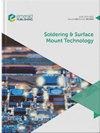Wetting characteristics of Sn-5Sb-CuNiAg lead-free solders on the copper substrate
IF 1.7
4区 材料科学
Q3 ENGINEERING, ELECTRICAL & ELECTRONIC
引用次数: 1
Abstract
Purpose The purpose of this paper is to investigate the wetting behaviors of Sn-5Sb-CuNiAg solders on copper substrates in different soldering processes and the effects of alloying elements on the wettability. Design/methodology/approach Sn-5Sb-CuNiAg solder balls (750 µm in diameter) were spread and wetted on 40 × 40 × 1 mm copper plates, in different fluxes, soldering temperatures and time. The contact angles were obtained by a home-made measuring instrument. The samples were polished and deep etched before analyzed by scanning electron microscopy. Energy dispersive X-ray spectroscopy was used to identify the composition of the joints. Findings The effects of different soldering processes and alloying elements on the wetting behaviors of Sn-5Sb-CuNiAg solders on copper substrates were calculated and expounded. The rosin-based flux could effectively remove oxidation layers and improve the wettability of Sn-5Sb-CuNiAg solders. Then with the increase of soldering temperature and time, the contact angles decreased gradually. The soldering processes suited for Sn-5Sb-CuNiAg solders were RMA218, 280°C and 30 s. Considered the effects of alloying elements, the wettability of Sn-5Sb-0.5Cu-0.1Ni-0.5Ag was relatively favorable on copper substrates. Besides, Ni could accumulate at the solder/Cu interface and form a jagged (Cu,Ni)6Sn5 IMC. Originality/value This work was carried out with our handmade experiment equipment and the production of the quinary lead-free solder alloy used in wetting tests belongs to us. The investigated Sn-5Sb-CuNiAg alloys exhibited higher melting point and preferable wettability, that was one of the candidates for high-temperature lead-free solders to replace high-Pb solders, and applied extremely to high temperature and frequency working environments of the third-generation semiconductors components, with a greater potential research and development value.Sn-5Sb-CuNiAg无铅焊料在铜衬底上的润湿特性
目的研究Sn-5Sb-CuNiAg钎料在不同钎焊工艺下对铜基体的润湿行为,以及合金元素对润湿性的影响。设计/方法/方法Sn-5Sb-CuNiAg焊球(750 直径µm)在40 × 40 × 1毫米的铜板,在不同的焊剂,焊接温度和时间。接触角是用自制的测量仪测得的。在通过扫描电子显微镜进行分析之前,对样品进行抛光和深度蚀刻。能量色散X射线光谱用于鉴定接头的成分。计算并阐述了不同焊接工艺和合金元素对Sn-5Sb-CuNiAg钎料在铜基片上润湿行为的影响。松香基助熔剂能有效去除Sn-5Sb-CuNiAg钎料的氧化层,提高钎料的润湿性。随着钎焊温度和时间的增加,接触角逐渐减小。适用于Sn-5Sb-CuNiAg焊料的焊接工艺为RMA218、280°C和30 考虑到合金元素的影响,Sn-5Sb-0.5Cu-0.1Ni-0.5Ag在铜衬底上的润湿性相对有利。此外,Ni可以在焊料/Cu界面积聚并形成锯齿状的(Cu,Ni)6Sn5 IMC.原始性/价值这项工作是用我们的手工实验设备进行的,用于润湿测试的五元无铅焊料合金的生产属于我们。所研究的Sn-5Sb-CuNiAg合金具有更高的熔点和更好的润湿性,这是高温无铅焊料替代高铅焊料的候选者之一,并极为适用于第三代半导体元件的高温和高频工作环境,具有更大的潜在研发价值。
本文章由计算机程序翻译,如有差异,请以英文原文为准。
求助全文
约1分钟内获得全文
求助全文
来源期刊

Soldering & Surface Mount Technology
工程技术-材料科学:综合
CiteScore
4.10
自引率
15.00%
发文量
30
审稿时长
>12 weeks
期刊介绍:
Soldering & Surface Mount Technology seeks to make an important contribution to the advancement of research and application within the technical body of knowledge and expertise in this vital area. Soldering & Surface Mount Technology compliments its sister publications; Circuit World and Microelectronics International.
The journal covers all aspects of SMT from alloys, pastes and fluxes, to reliability and environmental effects, and is currently providing an important dissemination route for new knowledge on lead-free solders and processes. The journal comprises a multidisciplinary study of the key materials and technologies used to assemble state of the art functional electronic devices. The key focus is on assembling devices and interconnecting components via soldering, whilst also embracing a broad range of related approaches.
 求助内容:
求助内容: 应助结果提醒方式:
应助结果提醒方式:


